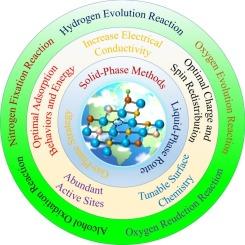Defect and non-metallic doping co-engineering in two-dimensional transition-metal carbide-based electrocatalysts for renewable energy conversion
IF 23.5
1区 化学
Q1 CHEMISTRY, INORGANIC & NUCLEAR
引用次数: 0
Abstract
As an emerging member of the two-dimensional (2D) material family, MXenes have gained significant attention for electrocatalysis because of their unique physical and chemical properties; however, their practical performance is often restricted by nanosheet restacking and inherently low intrinsic activity. To address these challenges, defect and non-metallic doping co-engineering are of interest as efficient strategies to improve the electrocatalytic performance of 2D MXenes. We herein comprehensively and critically discuss theoretical and experimental advances involved in the mechanism, characteristics, fabrication strategies, and applications of defect and doping co-engineered MXene-based materials for electrochemical reactions. Furthermore, the synergistic effects of defects and non-metallic dopants on the electronic structure, adsorption/desorption energies of intermediates, and possible electrocatalytic mechanism on 2D MXene-based materials are highlighted. Current challenges and prospects of defect and doping co-engineered MXene-based electrocatalysts are discussed. This review aims to elucidate the nature of defect and non-metallic doping co-engineering in MXenes, offering valuable insights for designing advanced MXene-based electrocatalysts.

可再生能源转换二维过渡金属碳化物电催化剂的缺陷与非金属掺杂协同工程
作为二维(2D)材料家族的新兴成员,MXenes由于其独特的物理和化学性质而在电催化方面受到了极大的关注;然而,它们的实际性能往往受到纳米片堆积和固有的低固有活性的限制。为了解决这些问题,缺陷和非金属掺杂协同工程是提高二维MXenes电催化性能的有效策略。在此,我们全面和批判性地讨论了电化学反应中缺陷和掺杂协同工程mxene基材料的机理、特性、制造策略和应用方面的理论和实验进展。此外,本文还强调了缺陷和非金属掺杂对电子结构、中间体吸附/解吸能的协同作用,以及二维mxene基材料可能的电催化机理。讨论了缺陷和掺杂协同工程mxene基电催化剂目前面临的挑战和前景。本文旨在阐明MXenes中缺陷和非金属掺杂协同工程的本质,为设计先进的MXenes电催化剂提供有价值的见解。
本文章由计算机程序翻译,如有差异,请以英文原文为准。
求助全文
约1分钟内获得全文
求助全文
来源期刊

Coordination Chemistry Reviews
化学-无机化学与核化学
CiteScore
34.30
自引率
5.30%
发文量
457
审稿时长
54 days
期刊介绍:
Coordination Chemistry Reviews offers rapid publication of review articles on current and significant topics in coordination chemistry, encompassing organometallic, supramolecular, theoretical, and bioinorganic chemistry. It also covers catalysis, materials chemistry, and metal-organic frameworks from a coordination chemistry perspective. Reviews summarize recent developments or discuss specific techniques, welcoming contributions from both established and emerging researchers.
The journal releases special issues on timely subjects, including those featuring contributions from specific regions or conferences. Occasional full-length book articles are also featured. Additionally, special volumes cover annual reviews of main group chemistry, transition metal group chemistry, and organometallic chemistry. These comprehensive reviews are vital resources for those engaged in coordination chemistry, further establishing Coordination Chemistry Reviews as a hub for insightful surveys in inorganic and physical inorganic chemistry.
 求助内容:
求助内容: 应助结果提醒方式:
应助结果提醒方式:


